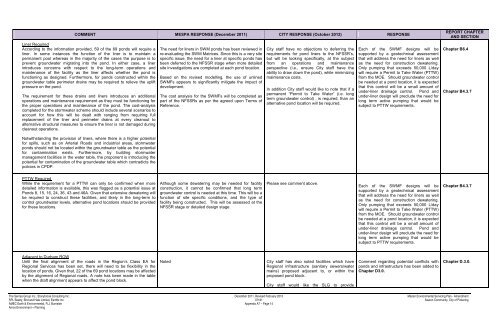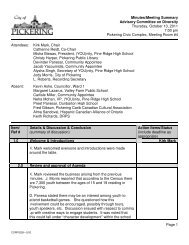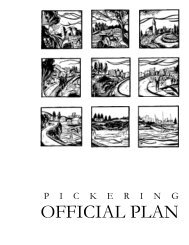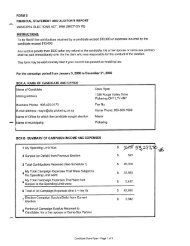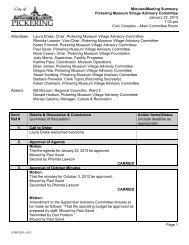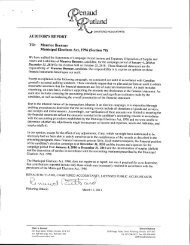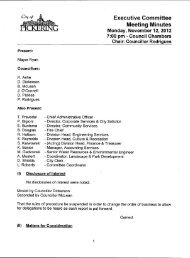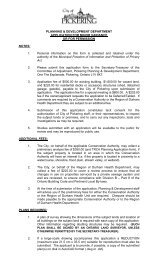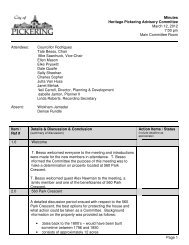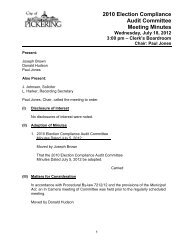Chapter A - Introduction - City of Pickering
Chapter A - Introduction - City of Pickering
Chapter A - Introduction - City of Pickering
You also want an ePaper? Increase the reach of your titles
YUMPU automatically turns print PDFs into web optimized ePapers that Google loves.
COMMENT MESPA RESPONSE (December 2011) CITY RESPONSE (October 2012) RESPONSE<br />
Liner Required<br />
According to the information provided, 59 <strong>of</strong> the 69 ponds will require a<br />
liner. In some instances the function <strong>of</strong> the liner is to maintain a<br />
permanent pool whereas in the majority <strong>of</strong> the cases the purpose is to<br />
prevent groundwater migrating into the pond. In either case, a liner<br />
introduces concerns with respect to the long-term operations and<br />
maintenance <strong>of</strong> the facility as the liner affects whether the pond is<br />
functioning as designed. Furthermore, for ponds constructed within the<br />
groundwater table perimeter drains may be required to relieve the uplift<br />
pressure on the pond.<br />
The requirement for these drains and liners introduces an additional<br />
operations and maintenance requirement as they must be functioning for<br />
the proper operations and maintenance <strong>of</strong> the pond. The cost-analysis<br />
completed for the stormwater scheme should include several scenarios to<br />
account for how this will be dealt with ranging from requiring full<br />
replacement <strong>of</strong> the liner and perimeter drains at every cleanout to<br />
alternative structural measures to ensure the liner is not damaged during<br />
cleanout operations.<br />
The need for liners in SWM ponds has been reviewed in<br />
re-evaluating the SWM Matrices. Since this is a very site<br />
specific issue, the need for a liner at specific ponds has<br />
been deferred to the NFSSR stage when more detailed<br />
site investigations are completed at each pond location.<br />
Based on the revised modelling, the use <strong>of</strong> unlined<br />
SWMFs appears to significantly mitigate the impact <strong>of</strong><br />
development.<br />
The cost analysis for the SWMFs will be completed as<br />
part <strong>of</strong> the NFSSRs as per the agreed upon Terms <strong>of</strong><br />
Reference.<br />
<strong>City</strong> staff have no objections to deferring the<br />
requirements for pond liners to the NFSSR’s,<br />
but will be looking specifically, at the subject<br />
from an operations and maintenance<br />
perspective (i.e., ensure <strong>City</strong> staff have the<br />
ability to draw down the pond), while minimizing<br />
maintenance costs.<br />
In addition <strong>City</strong> staff would like to note that if a<br />
permanent “Permit to Take Water” (i.e. long<br />
term groundwater control) , is required, than an<br />
alternative pond location will be required.<br />
Each <strong>of</strong> the SWMF designs will be<br />
supported by a geotechnical assessment<br />
that will address the need for liners as well<br />
as the need for construction dewatering.<br />
Only pumping that exceeds 50,000 L/day<br />
will require a Permit to Take Water (PTTW)<br />
from the MOE. Should groundwater control<br />
be needed at a pond location, it is expected<br />
that this control will be a small amount <strong>of</strong><br />
under-liner drainage control. Pond and<br />
under-liner design will preclude the need for<br />
long term active pumping that would be<br />
subject to PTTW requirements.<br />
REPORT CHAPTER<br />
AND SECTION<br />
<strong>Chapter</strong> B6.4<br />
<strong>Chapter</strong> B4.3.7<br />
Notwithstanding the provision <strong>of</strong> liners, where there is a higher potential<br />
for spills, such as on Arterial Roads and industrial areas, stormwater<br />
ponds should not be located within the groundwater table as the potential<br />
for contamination exists. Furthermore, by building stormwater<br />
management facilities in the water table, the proponent is introducing the<br />
potential for contamination <strong>of</strong> the groundwater table which contradicts the<br />
policies in CPDP.<br />
PTTW Required<br />
While the requirement for a PTTW can only be confirmed when more<br />
detailed information is available, this was flagged as a potential issue at<br />
Ponds 8, 15, 16, 24, 36, 43 and 46A. Given that extensive dewatering will<br />
be required to construct these facilities, and likely in the long-term to<br />
control groundwater levels, alternative pond locations should be provided<br />
for these locations.<br />
Although some dewatering may be needed for facility<br />
construction, it cannot be confirmed that long term<br />
groundwater control is needed at this time. This will be a<br />
function <strong>of</strong> site specific conditions, and the type <strong>of</strong><br />
facility being constructed. This will be assessed at the<br />
NFSSR stage or detailed design stage.<br />
Please see comment above.<br />
Each <strong>of</strong> the SWMF designs will be<br />
supported by a geotechnical assessment<br />
that will address the need for liners as well<br />
as the need for construction dewatering.<br />
Only pumping that exceeds 50,000 L/day<br />
will require a Permit to Take Water (PTTW)<br />
from the MOE. Should groundwater control<br />
be needed at a pond location, it is expected<br />
that this control will be a small amount <strong>of</strong><br />
under-liner drainage control. Pond and<br />
under-liner design will preclude the need for<br />
long term active pumping that would be<br />
subject to PTTW requirements.<br />
<strong>Chapter</strong> B4.3.7<br />
Adjacent to Durham ROW<br />
Until the final alignment <strong>of</strong> the roads in the Region’s Class EA for<br />
Regional Services has been set, there will need to be flexibility in the<br />
location <strong>of</strong> ponds. Given that, 22 <strong>of</strong> the 69 pond locations may be affected<br />
by the alignment <strong>of</strong> Regional roads. A note has been made in the table<br />
when the draft alignment appears to affect the pond block.<br />
Noted<br />
<strong>City</strong> staff has also noted facilities which have<br />
Regional infrastructure (sanitary sewers/water<br />
mains) proposed adjacent to, or within the<br />
proposed pond block.<br />
<strong>City</strong> staff would like the SLG to provide<br />
Comment regarding potential conflicts with<br />
ponds and infrastructure has been added to<br />
<strong>Chapter</strong> D3.0.<br />
<strong>Chapter</strong> D.3.0.<br />
The Sernas Group Inc., Stonybrook Consulting Inc. December 2011, Revised February 2013 Master Environmental Servicing Plan - Amendment<br />
SPL Beatty, Bird and Hale Limited, Earthfx Inc. 07161 Seaton Community, <strong>City</strong> <strong>of</strong> <strong>Pickering</strong><br />
AMEC Earth & Environmental, R.J. Burnside Appendix A7 – Page 14<br />
Amos Environment + Planning


